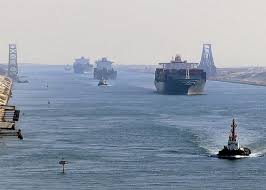The Suez Canal’s toll revenue has plummeted due to continued attacks on commercial vessels in the Red Sea and the Gulf of Aden. Over the past seven to eight months, toll revenues have dropped by 50-60% compared to the same period last year, with an estimated loss exceeding $6 billion (approximately ¥865.6 billion). The Egyptian government, which relies on the canal’s revenue as a major source of income, finds itself in a difficult situation.
According to “Port Watch,” the International Monetary Fund’s vessel traffic monitoring system, the average daily number of ships passing through the Suez Canal in the week leading up to September 17 was 29, less than half of the 73 ships recorded during the same period last year.
(Text by Hiro Yamamoto)
Photo courtesy of Suez Canal Authority

■Egypt’s President Sisi Highlights Impact of Rising Geopolitical Risks on Suez Canal Revenue at Police Academy Graduation Ceremony
According to local Egyptian media, President Abdel Fattah el-Sisi addressed the challenges posed by rising geopolitical risks in the Middle East during his speech at a police academy graduation ceremony held on September 29, 2024. During his address, President Sisi mentioned the significant decline in revenue from the Suez Canal.
Local reports indicate that the Suez Canal Authority initially projected toll revenue for the 2024-2025 fiscal year to reach $9 billion, a level close to the record-high $9.4 billion achieved in 2022-2023.
However, since the conflict between the Islamic organization Hamas and Israel in October 2023, commercial vessels in the Red Sea and Gulf of Aden have been targeted by Yemen’s Houthi militants, who have expressed solidarity with Hamas. As of early September, more than 90 commercial ships, unaffiliated with the U.S., the U.K., or Israel, have been attacked in the region. Including vessels associated with these three nations, the total number of affected ships has exceeded 100.

Global shipping companies, including those based in Japan, have been avoiding the Suez Canal, which is linked to the increasingly perilous Red Sea and Gulf of Aden, due to heightened risks. Currently, Japanese shipping companies are redirecting their container and car carrier vessels via the Cape of Good Hope in South Africa. This detour results in an additional 10-14 days of travel compared to the Suez Canal route. Consequently, demand for vessel capacity has surged, tightening shipping markets and pushing up freight rates globally.
(Text by Hiro Yamamoto)
Photo courtesy of Suez Canal Authority
〆スエズ運河、通航料収入60億㌦減、エジプト政府は要衝の収入減に苦悩
紅海・アデン湾地域で商船への攻撃が続いていることを受けて、スエズ運河の通航料収入が激減している。過去7―8カ月間の通航量収入は前年同期を50―60%下回り、60億㌦(約8656億円)超に達する減少だった模様だ。同運河の通航料収入を主要財源の一つとするエジプト政府は苦境に立っている。
国際通貨基金(IMF)の船舶航行情報モニターシステム「ポートウォッチ」によると、9月17日までの7日間にスエズ運河を通航した船舶は1日当たり平均で29隻となり、前年同期の73隻の半分以下にとどまった。
(Text by Hiro Yamamoto)
Photo courtesy= Suez Canal Authority
※日本語記事の続きは日本海事新聞でお読みください。
